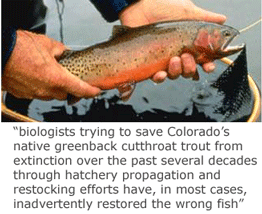 Just as DNA analysis regularly overturns seemingly solid eyewitness identifications in crime investigations, routine DNA analysis can also help biologists avoid blunders. In 28 August 2007 Mol Ecol, researchers from University of Colorado, New Mexico State University, Pisces Molecular, and Brigham Young University report that over 20 years of restocking efforts in western US aimed at restoring native populations of endangered greenback cutthroat trout Oncorhynchus clarkii stomias have mostly been restocking a non-native, non-endangered subspecies, Colorado River cutthroat trout O. c. pleuriticus. They trace the confusion to repeated introductions beginning in the late 1800s of Colorado River cutthroat trout throughout the native range of greenback cutthroat trout. The authors analyzed mitochondrial (COI, ND2) and nuclear (microsatellites, AFLP) DNA from 365 individuals from 15 locations in 3 major river drainage systems in Colorado and surrounding states. Distinct mtDNA lineages corresponding to each subspecies were corroborated by nuclear microsatellite and AFLP data. For another cautionary tale of repeated misidentification of a widely studied organism, see Siddall and colleagues’ entertaining June 2007 Proc R Soc paper scrutinizing commercially available medicinal leeches sold as Hirudo medicinalis.
Just as DNA analysis regularly overturns seemingly solid eyewitness identifications in crime investigations, routine DNA analysis can also help biologists avoid blunders. In 28 August 2007 Mol Ecol, researchers from University of Colorado, New Mexico State University, Pisces Molecular, and Brigham Young University report that over 20 years of restocking efforts in western US aimed at restoring native populations of endangered greenback cutthroat trout Oncorhynchus clarkii stomias have mostly been restocking a non-native, non-endangered subspecies, Colorado River cutthroat trout O. c. pleuriticus. They trace the confusion to repeated introductions beginning in the late 1800s of Colorado River cutthroat trout throughout the native range of greenback cutthroat trout. The authors analyzed mitochondrial (COI, ND2) and nuclear (microsatellites, AFLP) DNA from 365 individuals from 15 locations in 3 major river drainage systems in Colorado and surrounding states. Distinct mtDNA lineages corresponding to each subspecies were corroborated by nuclear microsatellite and AFLP data. For another cautionary tale of repeated misidentification of a widely studied organism, see Siddall and colleagues’ entertaining June 2007 Proc R Soc paper scrutinizing commercially available medicinal leeches sold as Hirudo medicinalis.
How might the future look with routine application of DNA ID as quality control? Incorporating DNA barcode analysis into Tree of Life studies is one useful approach, exemplified by two recent large-scale evolutionary studies published in January and April 2008 Syst Entomol, one on phylogenetic relationships in Saturnid silkmoths, and one on higher-level relationships among 12 families in ‘bombycoid complex’ of Lepidoptera. Both studies analyze COI barcodes of all specimens, “allowing confirmination of their identification for species present in the BOLD reference library and enabling future identifications of organisms whose identity is still pending.”
Robert Hanner, University of Guelph, is an early and strong proponent of DNA barcodes as quality control for biorepositories. He proposed the original BARCODE data standard (ref 1 below), explicitly calling for the accession of both vouchers and trace files with DNA barcodes for quality assessment and quality control (QA/QC) primate cell lines. A recent paper (ref 2 below) addresses QA/QC in animal cell lines including with DNA barcoding.
1. Lorenz, J.G., W.E. Jackson, J.C. Beck and R. Hanner. 2005. The problems and promise of DNA barcodes for species diagnosis of primate biomaterials. Philosophical Transactions of the Royal Society B 360: 1869-1877.
2. Cooper, J. K., Sykes, G., King, S., Cottrill, K., Ivanova, N. V., Hanner, R., & Ikonomi P. 2007. Species identification in cell culture: a two-pronged molecular approach. In Vitro Cell Dev Biol Anim. 2007 Oct 13; [Epub ahead of print; PMID: 17934781].
Wow – as sad as that is, it is almost kind of funny they could mess up such an important thing. I fish Lake Ontario and we have an aggressive stocking program in place but I have never heard of anything like what you mentioned above. Stocking the wrong fish? Geezz. Great article – thank you for sharing.
Kind regards,
Chad
Oops! That’s a big mistake that cost a ton of money… I guess in the future they are going to be examining DNA and making sure they have the correct species of fish when restocking.